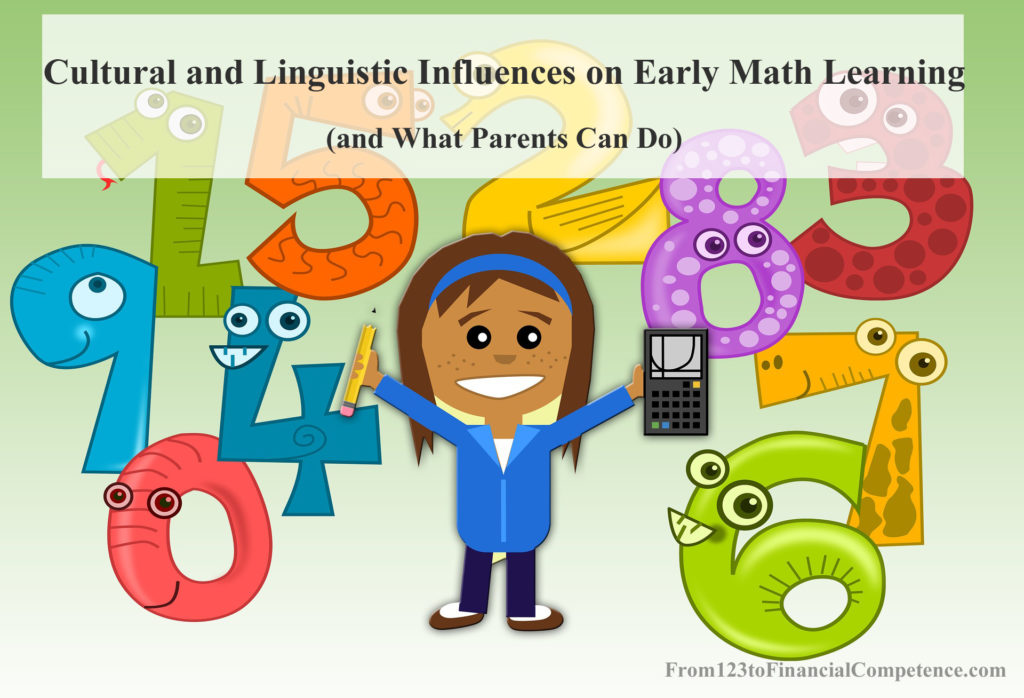The purpose of this writing is not about me taking a stand on which culture’s numbering system is better than whose. Reading the existing research on this topic fascinated me and I wanted to share. As a parent, it’s valuable being aware that there might be an interplay between culture, language and your child’s mathematical development.

Cultural and Linguistic Influences on Early Math Learning
During my quest to understand young children’s concept of numbers and counting, I came upon an article written by a group of researchers at MIT. Marmasse and colleagues discussed the following concepts and research implications in the article:
First, different cultures’ representations of numeric symbols and the number system can facilitate or impede the development of children’s mathematical understanding. This is true for both acquisition of math skills and computations.
Second, the linguistic aspects of the number system also influence a child’s understanding of base structure, place value* (unit, tens, etc.) and associated arithmetical computations.
Third, because counting requires use of a number system, the features of a culture’s particular numbering system can impact the development of counting.
Fourth, the more complicated the number system is, the harder it is for children to learn the counting sequence and associated arithmetical computations in later years.
Fifth, Chinese (and other Asian) children have an advantage over American (and other Western) children when it comes to children’s number understanding and arithmetic competence. The basis for this argument is that the Asian number systems and linguistic representations are much more logical, consistent and transparent compared to the Western number systems. Thus, Asian children in general have a much easier time learning number and math concepts and computations than their peers from Western countries.
***********************************************************
Being bilingual Chinese and English myself and having learned two number systems at different times in my life, I was fascinated by the discussion. I became curious and did some retrospections. “What was my experience like learning the American number system?” “I was already 10 when I started learning English and had already mastered the foundations of numbers and arithmetics. Did the fact that the American number system was more challenging to learn impede my math abilities thereon compared to my abilities if I had continued my math education in China?”
As a parent committed to having my daughter learn Chinese as her primary language at home, naturally, I was also intrigued. Despite having had to learn two number systems, it never occurred to me that the features of a culture’s numbering system and numeric representations can influence a child’s math development. After I finished reading Marmasse and colleagues’ article, I searched the web to learn more. Luckily, I found several additional articles that might’ve just satisfied my curiosity.
Cultural Variations of the Number System and Numeric Representations
All the articles I have read generally suggested that there is a significant difference in how the number system in Western and Asian (such as China, Japan, and Korea) languages are constructed. The Asian number systems are more intuitive, transparent, and logical. They are organized such that the numerical names are compatible with the traditional 10-based numeration system.
One example is in the Chinese counting system, where the spoken numbers correspond exactly to their written equivalent: 11 is spoken as ‘ten-one’, 12 is ‘ten-two,’ and so on.
The same rule applies for larger numbers, such that 20 is ‘two-ten,’ 59 is ‘five-ten-nine’ and so on. Hence, new numbers could easily be inferred in Chinese and it’s clear that the numbers are organized according to a base-ten system.
[In my experiences of teaching my daughter numbers and counting, I found the above implications to be accurate about the Chinese numbering system. I would teach my daughter how to say ‘20, 21, and 22’, and after several rounds of instruction, my daughter would go on to say aloud ’23, 24, 25’ and so on until ‘29’. She was able to do this because she was already familiar with the numbering pattern after having learned how to say ’11 to 19’.]
On the other hand, the Western number system is “arbitrary, complicated and doesn’t seem to make sense.” The English words ‘eleven’ and ‘twelve’ do not provide clear clues for their cardinality nor the base system.
In addition, various phonemic modifications further complicate number learning for English speakers. In numbers, 13-19, ten becomes –teen, three becomes thir-, and five becomes fif-. Above 19, ten becomes –ty for tens starting from 20, two becomes twen– in the twenties and four becomes for– in the forties.
Moreover, as an English speaker says fourteen, sixteen, seventeen, eighteen and nineteen, one would think that you would also say one-teen, two-teen, and three-teen for numerals 11, 12 and 13 respectively, however, that’s not the case at all.
To further complicate the number system, for numerals in the teens, English speakers put the decade second and the unit number first: fourteen, seventeen, eighteen. For numbers above twenty, on the other hand, the English speaker put the ‘decade’ first and the unit number second: twenty-one, twenty-two.
Other Western cultures’ number systems can be even more irregular. For example, in French, 92 is said as “four twenty twelve,” corresponding to 4*20+12.
The Chinese number system can also be directly mapped onto Arabic numbers: for example, 17 is ‘ten-seven‘ in Chinese, making it obvious that the ‘1’ is a ’10.’ In contrast, place values of English numbers are obscured by three forms of ten (ten, -teen, and -ty), and the fact that the order of reading numbers does not necessarily align with the Arabic numbers (e.g., seventeen vs. seventy). Such irregularities mask place values* and hinder English children’s arithmetic development.
How Might the Advantage Translate into Arithmetic Competence for Asian Children?
The regularity and transparency of the Asian number system (and its linguistic representations) means that Asian children can perform basic functions, such as addition, far more easily. Ask an English-speaking seven-year-old to add thirty-seven plus twenty two in her head, and she has to convert the words to numbers (37 + 22). Only then can she do the math: 2 plus 7 is 9 and 30 + 20 is 50, which makes 59.
Ask an Asian child to add three-tens-seven and two-tens-two, and then the necessary equation is right there, embedded in the sentence. No number translation is necessary: it’s five-tens-nine.
Parenting Factors on Children’s Early Math Learning
In addition to the role of cultural and linguistic factors influencing your child’s acquisition of number concepts and arithmetic competence, as parents, we certainly can change the trajectories of our children’s early math development. According to Miller, Kelly & Zhou (2005), parenting factors (such as parenting values and parenting beliefs and practices) are equally important influencing children’s math skills and abilities.
Your responses to the following questions can say a lot about your child’s early and later math skills.
First, do you believe both literacy and mathematical skills are as equally important to teach your child during the early childhood years or do you place more importance on reading and vocabulary (or building math skills)?
Second, once your child enters formal school, do you continue to devote a relatively large amount of effort teaching your child academic subjects (especially, on math) or would you switch your focus and time on extracurricular activities (such as music lessons and sports)?
Third, do you take the time to communicate with your child’s teacher(s) on his/her academic performance and become heavily involved in helping your child with homework?
Fourth, do you believe that academic achievement is related to effort or innate intellectual ability?
*******************************************************************
There’s not much we can do to change our culture’s number system or numeric representations. These systems are pretty much set in stone for most cultures. The great news is that, at a smaller and more intimate level (as Miller, Kelly & Zhou suggested), we can identify effective ways to help our children build math skills both before and after they begin formal school. Let’s focus on the things that we can change!
What are you doing at home (and with your child’s school) to help your child develop his/her math abilities and reinforce those skills?
What are your strengths (consider some of those parenting factors mentioned above)?
*Place value: Place-value knowledge refers to the knowledge of the value of each digit by considering its place in a multi-digit number, such that each ‘5’ in 555 is understood as 5 hundreds, 5 tens, and 5 units, respectively.
References:
Numerical Mechanisms and Children’s Concept of Numbers
Counting in Chinese: Cultural Variation in Basic Cognitive Skill


Comments are closed.